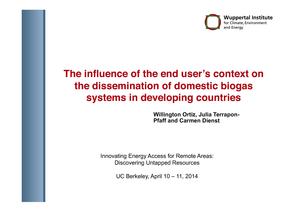Click here to register!
The Influence of the End Users’ Context on the Dissemination of Domestic Biogas Systems in Developing Countries
The Influence of the End Users’ Context on the Dissemination of Domestic Biogas Systems in Developing Countries
Presenter: Willington Ortiz, (Wuppertal Institute for Climate, Environment and Energy GmbH, Germany)
Rapporteur: Max Morrison
Overview
| Long term mass dissemination programmes for domestic biogas have led to a significant increase in the volume of installations in some Asian countries. While these successes can offer insights for the targeted countries, the only moderate progress in some other countries, underline the need for understanding of favorable conditions and related sociotechnical context. By applying a quasi-evolutionary sociotechnical transition perspective, this study explores how contextual factors may influence the adoption and diffusion process. The analysis suggests that the adoption of domestic biogas requires adjustments to sociotechnical configurations that go beyond the cooking system; notably animal tenure and crop production. Due to the diversity of factors involved, greater emphasis on testing appears advisable, particularly at the outset of the dissemination process.[1] |
Issues Presented
► Please see the presentation.
- The digestor makes up the central part of the biogas system, but peripheral components are as important a part (Ie end use, animal tenure, storage reservoirs, interaction w/ agricultural system)
- Installation of biogas tends to be very extensive or not extensive at all.
- High use results from long term support from central government, as well as some microfinance.
- Is long term central support the only way to achieve high use?
- Context by country affects adoption and diffusion process.
- User level – adoption
- Population level – Diffusion
- Is long term central support the only way to achieve high use?
- The incoming sociotechnical system develops in the presence of other already established systems.
- Task is to identify these incumbent systems and the way they may interact with new systems.
- With respect to domestic biogas, the user has a huge impact on the adoption and dissemination process.
- Identify factors that influence dissemination of different technologies and group them by sociotechnical structure they are associated with.
- 2 main groups of sociotechnical structires.
- High adopter agency
- Animal tenure + Crop Production
- Buildings may need to be modified to accommodate collection of feedstock.
- Experimentation is required with respect to the effluent’s effect on crops and what to do with the waste such that it is most effectively used.
- Low adopter agency
- How can biogas integrate with existing supply systems to more effectively expand?
Q & A
1. How can we encourage the mindset change regarding animal manure especially in African countries?
- Differences between Asian and African countries in terms of adoption of biogas.
- Fertilizer is a main source of income from biodigestor.
2. How do you deal with the mindset change required to see animal manure as a asset rather than waste product?
- These issues are beyond the scope of this study. Demographic change is a very difficult issue to tackle.
3. Comment: The reactor can be moved to community level. This will allow sale of manure, which can help change its perceived utility. This can increase perceived modernity of the location, allowing a more centralized model, meaning piped gas and central fertilizer sales.
4. Why are Asian countries at the forefront of adoption? What about the model in Asian countries encourages such growth?
- There is a stronger focus on enegy/carbon credit than on the utility of fertilizer. The perceived scope of affect of biogas is too limited as of this moment.
- Comment: india has revered cows, so the idea of interacting w/ manure is more accepted. Also the system started as a relatively simple closed system, so the adoption was easier to facilitate.
5. Perhaps agricultural waste can be used to bridge the gap between people and the manure? There has been much more thought put into animal manure. Cows are dominant, but experimentation is occurring with other animals that may be more local to the context of each country/region.
- Comment: Re Asian markets: microfinance process is more extablished and favorable to biogas in Asian countries. In Africa other organizations are pushing microfinance institutions to fund biogas rather than the other way around.
6. What are the mechanisms for dissemination in those countries that have a large penetration?
- Common denominator is >30 years of support. Decentralized support – microfinance, subsidies. Subsidies taper off as market penetration increases.
References
- ↑ The influence of the end user’s context on the dissemination of domestic biogas systems in developing countries.Willington Ortiz, Julia Terrapon-Pfaff and Carmen Dienst





















